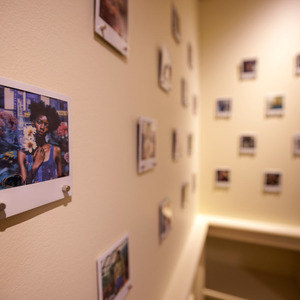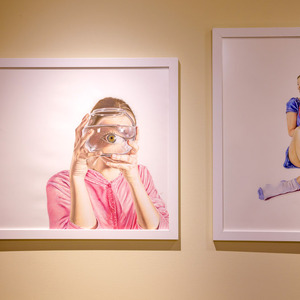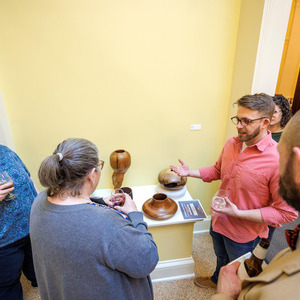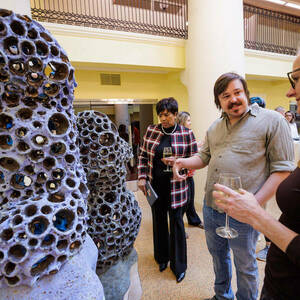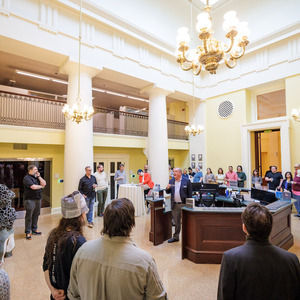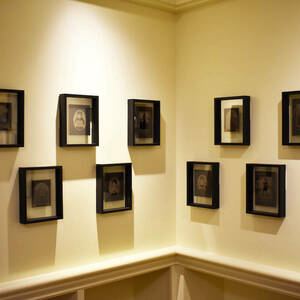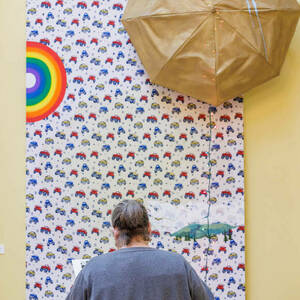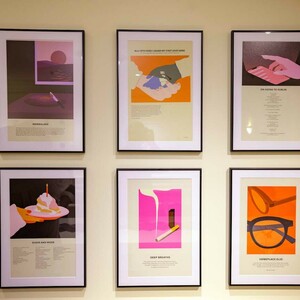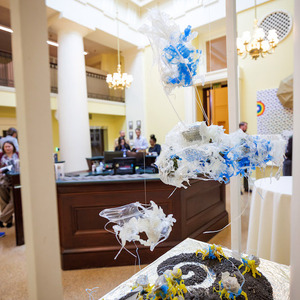
Master of Fine Arts (MFA) students in the University’s studio art and design programs unveiled their latest work to the campus community on March 8 at the opening reception of this year’s Solarium Art Show in Bond Hall. An annual collaboration between the Graduate School and the Department of Art, Art History, and Design, this year’s exhibition — titled FREQUENCIES, in a nod to the “vibrational energy” of this year’s pieces — featured nine students across a variety of visual disciplines:
- Norah Amstutz — Ceramics/Pottery
- Nik Swift — Visual Communication Design
- Riley Fichter — Sculpture
- Jacob Lehmann — Painting
- Emma Ryan — Painting
- Grace Hamilton — Visual Communication Design
- Joseph Matty — Photography
- Hans Miles — Ceramics
- Chip Sox — Sculpture
At the opening reception, Tom Fuja, interim dean of the Graduate School, welcomed visitors to the light-filled solarium space in Bond Hall — which will play host to the art through at least the end of the spring semester — and noted the symbiotic nature of the Solarium exhibition:
"The Graduate School has a scope that spans Notre Dame, and this exhibition lets us partner with some of our University’s finest artists to create a wonderful space that our students, faculty, and staff can all enjoy. We are so grateful that the MFA students are willing to share their gifts with us."
Fuja also announced the recipients of three awards, which were selected by an independent jury:
- Chip Sox — Best Artist/Designer Award
- Nik Swift — Best in Show Award
- Norah Amstutz — People’s Choice Award
Art as a means for social and political engagement
Jason Lahr, associate professor of painting and drawing and director of graduate studies for the art program, helped shape the direction of this year’s exhibition, and was quick to highlight the ways that the annual Solarium tradition gives MFA students the chance to participate in a broader conversation about the motivation and passion driving their work:
“I think a lot of our students are very much engaged in a variety of social and political issues in our program. And the opportunity to share what they're doing with their peers across the University — with other graduate students, with the administrators that are here, with people visiting — is really important for them. I think it's a struggle often for the arts to connect the idea of 'making' with research, and I think showing the work in this context makes that connection clearer.”
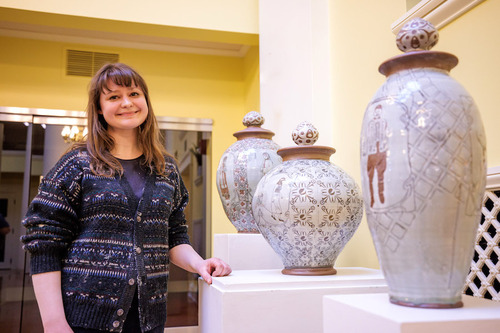
In terms of social and political engagement, one influential backdrop for the 2023 FREQUENCIES show was the ongoing war in Ukraine. First year ceramics student Norah Amstutz emigrated from Ukraine to the United States with her family when she was only three years old. But her family’s deep roots with Ukrainian culture have continued to shape her life and art, including the urns she submitted for this year’s Solarium exhibition. The urns depict her family’s ongoing struggle to hold onto their Ukrainian identity, amidst a sea of external pressures. “I initially started this work to do something for my family,” says Amstutz. “To make them feel good. They came here and started from nothing. And to now have their faces displayed at Notre Dame, at this place of immense importance in the country, is just kind of unbelievable.”
Amstuz also hopes that her work moves viewers away from only focusing on present-day Ukraine as a war-torn battlefield. “I want to evoke a sense of pride in this culture,” she says. “You know, nobody knew about Ukraine until all this stuff started happening. So just showing a more beautiful side to what's happening right now and reminding everyone what's there. It’s really about showing the culture in a positive light.”
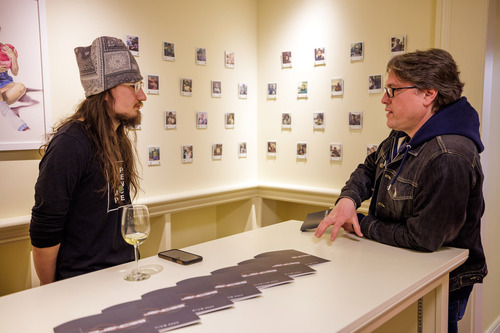
Second year visual communication design student Nik Swift also found himself grappling with the war, albeit from a different angle. His Solarium project displays dozens of polaroid-style photographs of people meant to represent LGBT individuals in Russia, who find themselves facing discrimination and feeling like outcasts because of policies implemented by Vladimir Putin’s government. Swift says an important part of this project is raising awareness of their plight: “First and foremost, I hope that people experience a sense of empathy, a sense of recognizing the humanity of this community that is currently being oppressed by this particular regime. And hopefully they go and learn more about that issue.”
There is also a significant twist in Swift’s “Resilience in Bloom” Solarium piece. With one exception, all of the individuals in the photographs were generated by artificial intelligence algorithms. This was intended to protect the LGBT individuals in Russia by not having to publicly share their faces, but it was also a way for Swift to engage the suddenly explosive issue of artificial intelligence (AI) as it begins to seep into everyday life. “I hope that people can get the lived experience of being somewhat deceived by the use of artificial intelligence,” he says. “I think that with the proliferation of AI in today's culture, the malicious potential of AI to deceive is immense. And I think that the more that people have that lived experience of seeing something that they perceive as maybe a photograph, but then find out actually isn't — that it’s actually created by AI — that gives that person a sense of armor. They're being deceived in a benign way right now so that they get this protection against the more malicious uses or employment of AI deception in the future.”
Preparation for life and careers beyond the Golden Dome
Beyond simply having the opportunity to showcase their work, Prof. Lahr points out that an exhibition like FREQUENCIES can help MFA students begin to prepare for future careers in art and design. “There's a bit of a professionalization that comes with this,” he says. “As they're going into the world as artists and designers, they're going to encounter people who are trained or have experience with what they do. But they're also going to encounter a lot of people who don't. So to get the opportunity to talk about what they do to interested non-experts is a really excellent way for them to develop their professional skill set.”
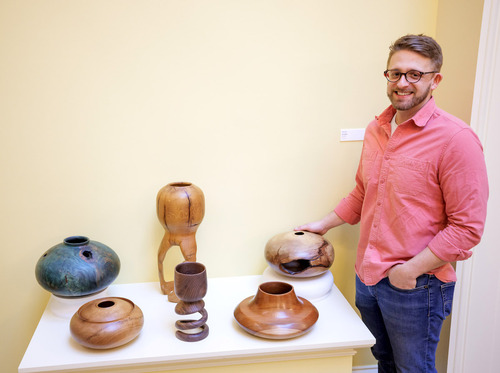
Chip Sox, a third year sculpture student, says his cohort has not had many opportunities to display their work for the public, primarily due to the disruption caused by the COVID-19 pandemic during their first two years in the program. He says that lack of openings made participating in this year’s Solarium exhibition that much sweeter: “This is kind of the biggest reception I've had in my MFA experience. So it does feel quite rewarding at this point.”
For Nik Swift, who left a stable 9-to-5 job in the tech industry to pursue his MFA, formal venues to share his work are hugely important. “People were very confused and concerned when I told them that I was going to make a change and go to art school,” he recalls. “So to have my work received [positively] and to be able to talk about it with people and to feel connected with people, it means the world. There's a kind of a validation to taking a risk and having that risk pay off. It's such an honor, and I feel so privileged to be able to do what I'm doing right now.”
Norah Amstutz expressed a similar sense of validation connected to opportunities like Solarium. “I'll be talking to someone who's studying engineering or who’s going to go work at NASA,” she says, ”and they're like, ‘What are you doing?’ And here I am just playing with mud. So it feels really validating to get to share my work and have it be appreciated.”
The exhibition is located in the Graduate School offices at 117 Bond Hall, and interested members of the Notre Dame community are encouraged to view the work in person during regular office hours.



